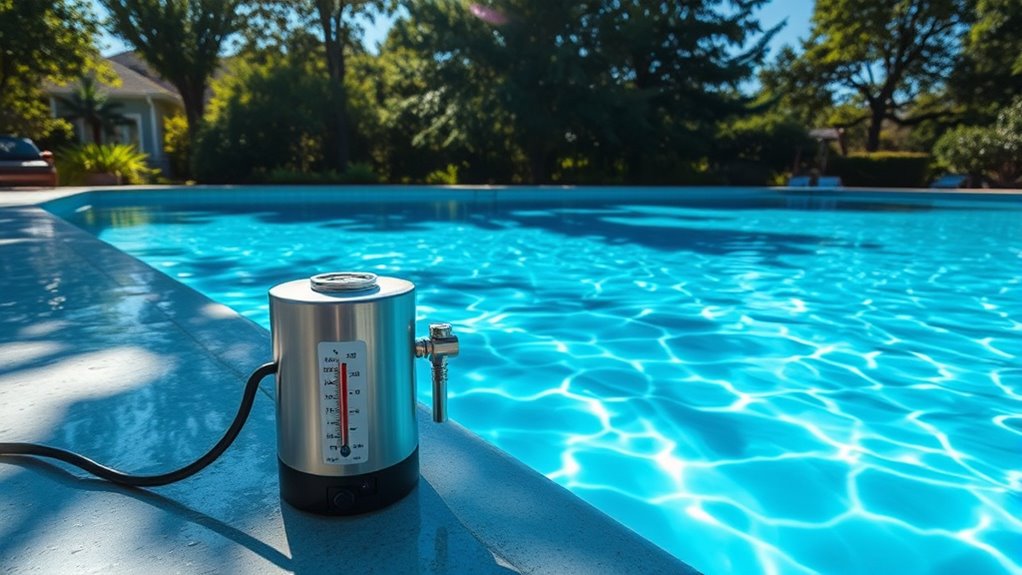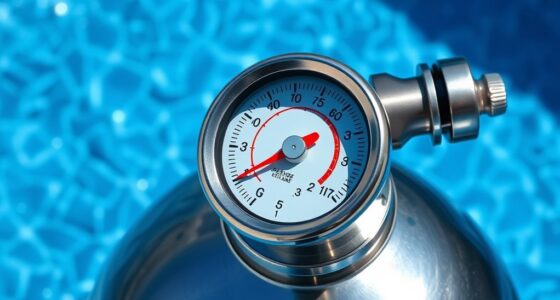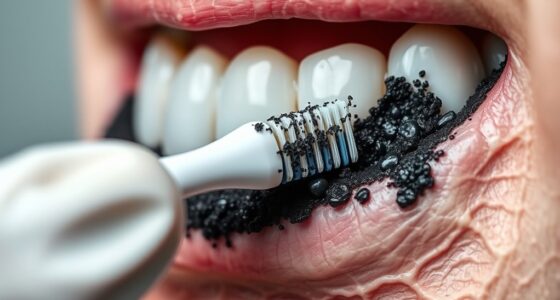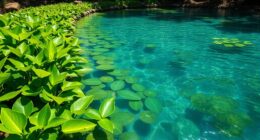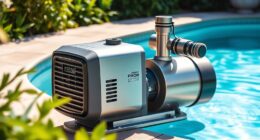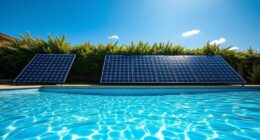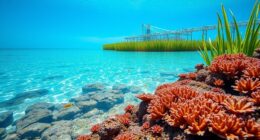Sunlight’s UV rays break down chlorine faster, requiring you to add chemicals more often. Shade helps by slowing this process, so chlorine stays effective longer. Cyanuric acid acts as a stabilizer, shielding chlorine from UV damage and extending its lifespan. Managing CYA levels and adjusting your chlorine doses based on how much sun your pool gets can keep your water clean and safe. To learn more about optimizing your chlorine plan, keep exploring these factors.
Key Takeaways
- UV rays break down chlorine faster, requiring more frequent dosing in direct sunlight.
- Shade reduces UV exposure, helping chlorine last longer and decreasing the need for frequent additions.
- Cyanuric Acid stabilizes chlorine against UV degradation, extending its disinfectant effectiveness.
- Proper CYA levels protect chlorine from UV, but excess CYA can weaken overall water sanitation.
- Regular testing and adjusting chlorine and stabilizer levels based on sunlight exposure optimize pool maintenance.
How Sunlight Accelerates Chlorine Depletion
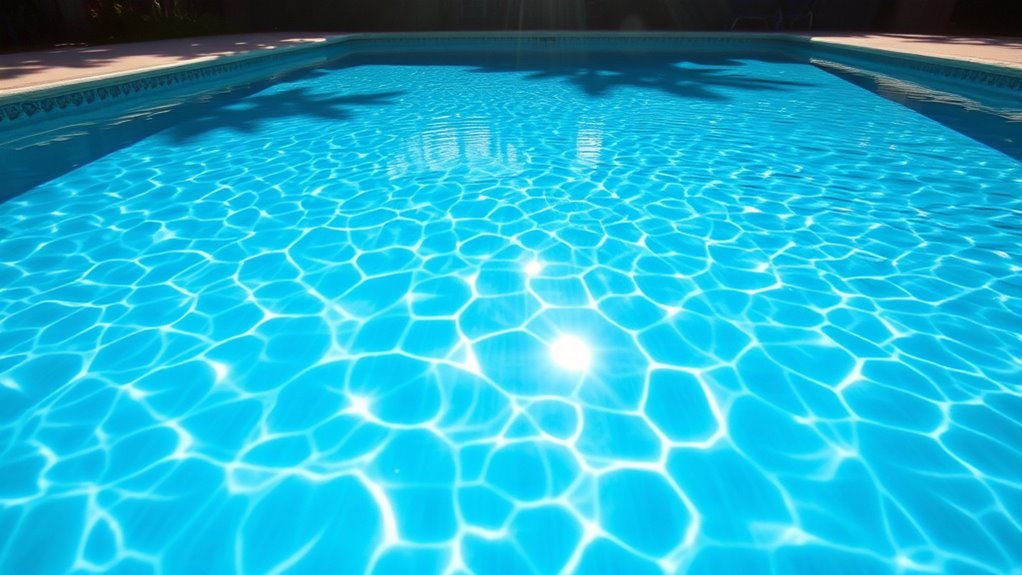
Sunlight plays a significant role in speeding up chlorine depletion in swimming pools. When ultraviolet (UV) rays hit the water, they break down chlorine molecules, reducing their disinfectant power. This process, called photolysis, happens quickly, especially in direct sunlight. As chlorine molecules break apart, your pool’s sanitizer levels drop, making it easier for algae and bacteria to grow. The faster chlorine depletes, the more often you’ll need to add chlorine to keep your pool safe. Additionally, UV rays can cause chloramines—compounds that produce unpleasant odors and irritate your eyes—to form faster. If you want to maintain proper sanitation, understanding how sunlight accelerates chlorine loss helps you plan better and adjust your chlorination routine accordingly. Effective filtration and proper chemical management are essential for maintaining water quality despite UV exposure.
The Role of Shade in Protecting Chlorine Levels
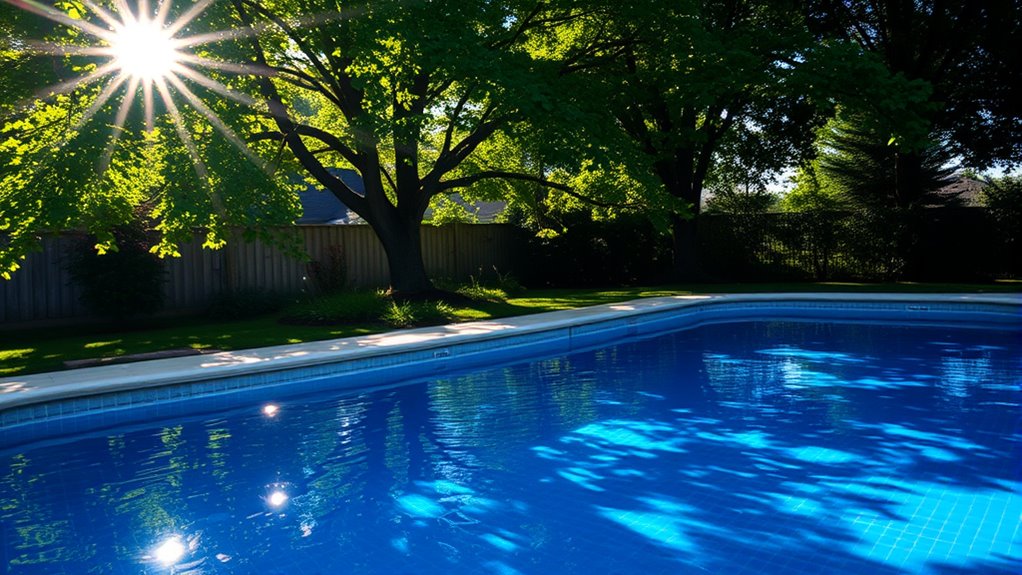
Shade plays a crucial role in preserving your pool’s chlorine levels by reducing exposure to UV rays that break down disinfectants. When your pool is shaded, fewer UV rays reach the water, slowing the rate at which chlorine depletes. This means you don’t need to add chlorine as often, saving you time and money. Shade also helps maintain more stable chlorine levels, preventing sudden drops that can lead to algae growth or bacteria buildup. Trees, umbrellas, or even a pool cover can provide effective shade, especially during peak sunlight hours. Keep in mind, while shade reduces chlorine loss, it doesn’t eliminate the need for proper water testing and maintenance. Using shade strategically can be a simple yet effective way to extend your chlorine’s lifespan and keep your pool cleaner longer. Additionally, incorporating nutritional benefits of chia seeds into your diet can support overall health and wellness.
Understanding Cyanuric Acid and Its Function
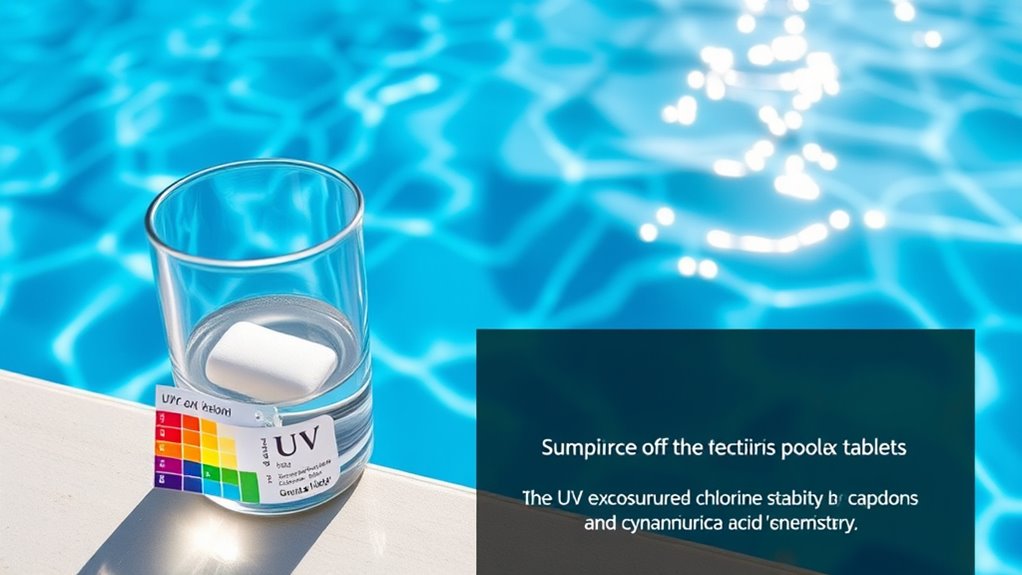
Have you ever wondered how to keep your pool’s chlorine effective longer? That’s where cyanuric acid (CYA) comes in. CYA acts as a stabilizer, protecting your chlorine from being broken down by sunlight’s UV rays. Without it, chlorine dissipates quickly, especially on sunny days. By adding CYA, you create a shield that allows your chlorine to last longer in the water, reducing how often you need to add more. It works by binding to chlorine molecules, helping them resist rapid degradation. Additionally, HEPA filtration can assist in removing airborne contaminants around your pool area, contributing to overall water and air quality. However, too much CYA can reduce chlorine’s effectiveness, so maintaining the right balance is key. Understanding how CYA functions helps you manage your pool’s chemistry, making sure your chlorine stays active and your water stays clean.
How CYA Shields Chlorine From UV Rays
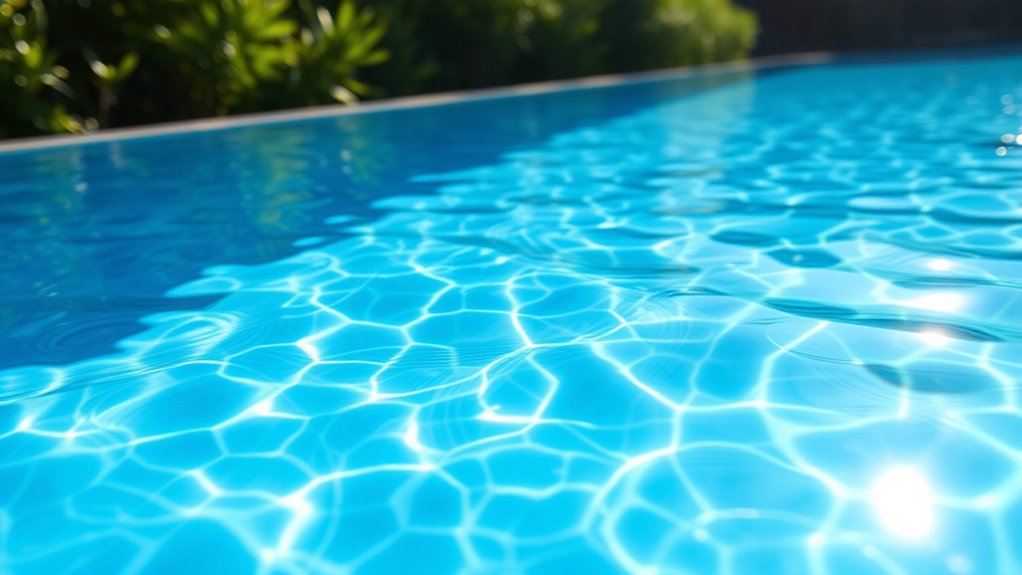
Cyanuric acid (CYA) acts as a protective barrier that prevents UV rays from breaking down chlorine molecules in your pool. When sunlight hits the water, UV rays can rapidly degrade free chlorine, reducing its effectiveness. CYA binds to chlorine, forming a stabilized compound that resists UV breakdown. This means your chlorine remains active longer, helping maintain a consistent disinfectant level. Without enough CYA, UV rays quickly destroy chlorine, leading to more frequent top-offs and potential water quality issues. Proper CYA levels create a shield that allows chlorine to work more efficiently, especially in sunny conditions. By understanding how CYA protects chlorine, you can better manage your pool’s sanitation and reduce the need for constant chemical adjustments. Additionally, understanding the role of Vetted in pool chemical management can help optimize your water quality.
Optimal Chlorine Levels for Different Sunlight Conditions
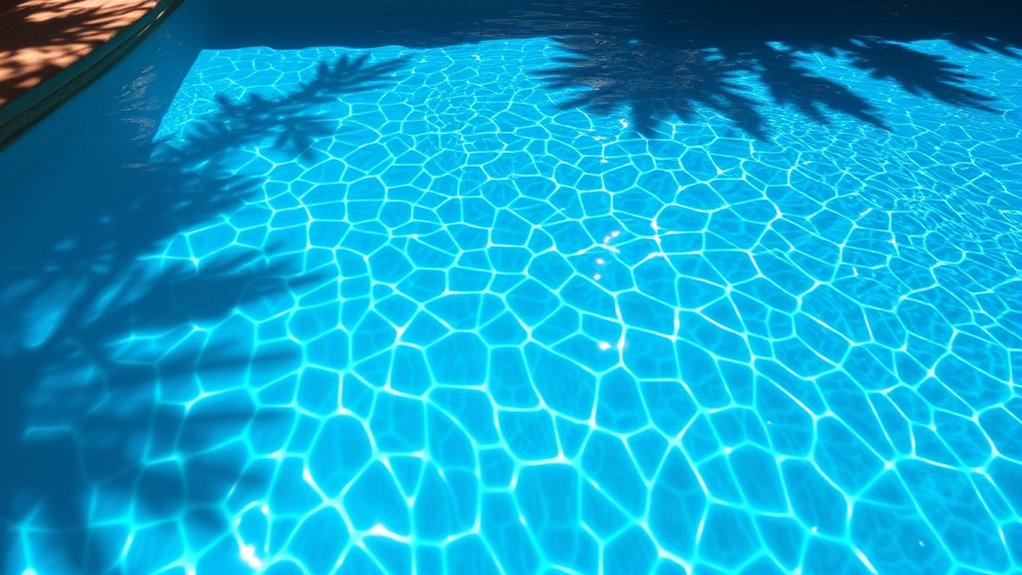
Maintaining the right chlorine levels depends heavily on sunlight exposure. In direct sunlight, you’ll need higher chlorine levels—around 7.5 to 10 ppm—to compensate for rapid UV breakdown. Shade reduces chlorine loss, so maintaining 3 to 5 ppm is usually sufficient. If your pool gets a lot of sun, plan to test and add chlorine more frequently to keep levels steady. Overcast days slow chlorine degradation, so you can lower your target levels slightly. Always monitor your free chlorine regularly, especially during seasonal changes or weather shifts. Adjust your chlorination plan based on sunlight intensity and duration. Properly balancing chlorine ensures your pool stays safe, sanitized, and clear, no matter how much sun it gets. Regularly checking your chlorine levels can help prevent issues caused by UV exposure.
Strategies to Maintain Chlorine Efficacy in Sunny Days
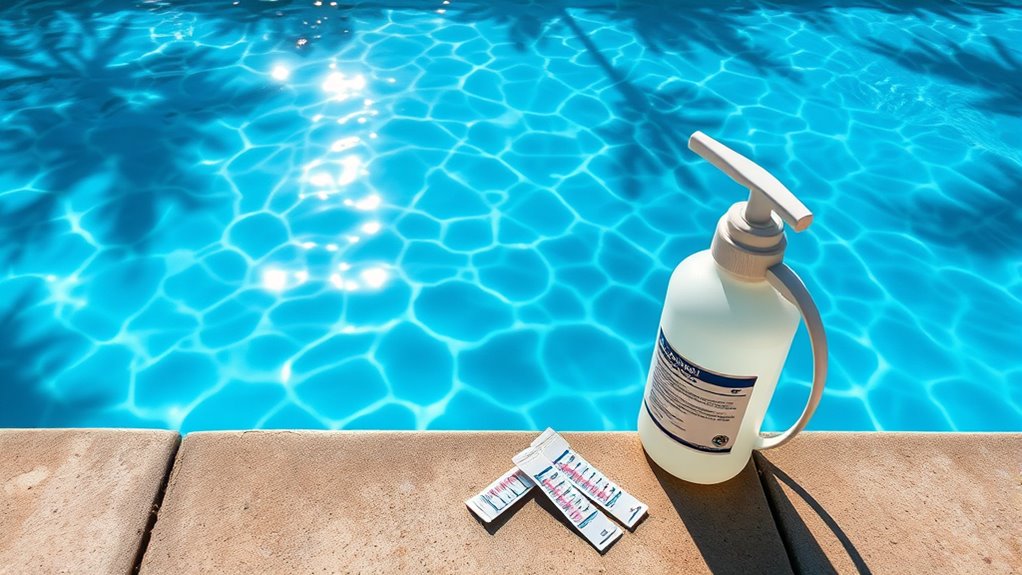
On sunny days, your pool’s chlorine can quickly break down, so it’s crucial to take specific actions. Covering pool surfaces, using stabilizer agents, and testing chlorine levels regularly help maintain its effectiveness. These strategies ensure your pool stays sanitized despite increased sunlight exposure. Incorporating water quality testing into your routine allows for timely adjustments and prevents chlorination issues.
Cover Pool Surfaces
Covering your pool surfaces during sunny days is one of the most effective ways to protect chlorine from rapid degradation. A solid cover or pool tarp blocks direct sunlight, considerably reducing UV exposure that breaks down chlorine molecules. This simple step helps maintain your sanitizer levels longer, saving you time and effort. When the pool is covered, fewer chemicals are lost to evaporation and UV damage, which means you’ll need fewer chlorine additions. Make sure the cover fits tightly to prevent sunlight from seeping in through gaps. If a full cover isn’t practical, use floating covers or solar blankets during peak sunlight hours. These barriers not only shield your chlorine but also help retain heat and reduce water evaporation, making your pool maintenance more efficient. UV protection strategies are essential for optimizing chlorine efficacy in sunny conditions.
Use Stabilizer Agents
Using stabilizer agents like cyanuric acid is an effective way to keep your chlorine working longer during sunny days. These agents form a protective layer around chlorine molecules, reducing their breakdown caused by UV rays. By adding cyanuric acid to your pool, you can extend the lifespan of your chlorine, meaning you won’t need to add as much as often. It’s important to maintain the proper cyanuric acid level—generally between 30-50 ppm—to maximize effectiveness without causing issues like algae growth. Regularly monitoring your stabilizer levels ensures your chlorine remains protected. Using stabilizer agents is especially helpful if your pool is exposed to direct sunlight most of the day. This simple step helps you maintain clear, sanitized water even during the hottest, sunniest days. Incorporating vertical storage solutions can also help you keep your pool supplies organized and easily accessible for maintenance.
Regular Chlorine Testing
Regularly testing your chlorine levels is essential to guarantee your pool stays sanitized, especially during sunny days when UV rays can rapidly diminish chlorine effectiveness. Use a reliable test kit to check free chlorine at least twice a day—morning and late afternoon—when sunlight is strongest. If levels drop below the recommended range (1-3 ppm), add chlorine promptly to maintain proper sanitation. Keep a log of your test results to track trends and adjust your chlorination routine accordingly. Remember, consistent testing helps you catch problems early before bacteria or algae develop. During hot, sunny days, you might need to increase your chlorine doses or use stabilized chlorine to sustain effective levels. Staying vigilant with testing ensures your pool remains safe, clear, and inviting all season long. Additionally, understanding the effect of UV rays on chlorine can help you better plan your maintenance routine.
Adjusting Your Chlorine Routine Based on Sun Exposure
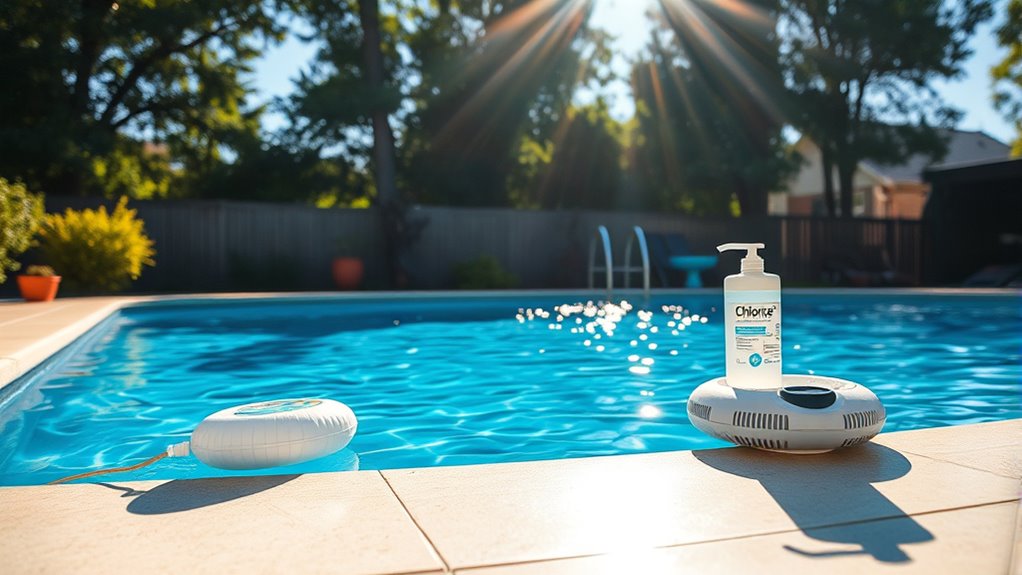
Sunlight breaks down chlorine quickly, so you need to adjust your routine when your pool gets more sun. Using shade can help maintain proper chlorine levels and reduce the need for frequent additions. Keep an eye on your chlorine and consider adding more or using a cover during peak sun hours. Additionally, understanding how UV exposure affects chlorine stability can help you develop more effective maintenance strategies.
Sunlight Impact on Chlorine
When your pool is exposed to sunlight, the chlorine in the water quickly breaks down, reducing its effectiveness at sanitizing. UV rays cause chlorine molecules to degrade faster, meaning you’ll need to adjust your routine to keep your water safe. To understand the impact better, consider this table:
| Sun Exposure Level | Chlorine Degradation Rate | Recommended Adjustments |
|---|---|---|
| Full Sun | Fastest | Increase chlorine levels, use stabilizer |
| Partial Shade | Moderate | Slight increase needed |
| Full Shade | Slowest | Maintain regular levels |
| Overcast Days | Minimal | Slight or no increase |
Monitoring sunlight exposure helps you determine when to boost chlorine or add stabilizer, ensuring your pool stays clean and safe.
Shade and Chlorine Levels
Shade plays a significant role in maintaining proper chlorine levels in your pool. When your pool is shaded, the sun’s UV rays are less intense, which slows down chlorine loss. If you notice your chlorine levels dropping quickly during sunny days, but stay steady in shaded areas, it’s a sign you should adjust your routine. You might need to add chlorine less frequently or lower your dosing. Conversely, in open, sunny areas, you’ll need to increase chlorine or use stabilized chlorine products to combat rapid UV degradation. Monitoring your chlorine levels regularly helps you respond to these changes promptly. By understanding how shade influences chlorine retention, you can fine-tune your maintenance schedule for a cleaner, safer pool with less chemical waste.
Common Mistakes That Lead to Chlorine Loss
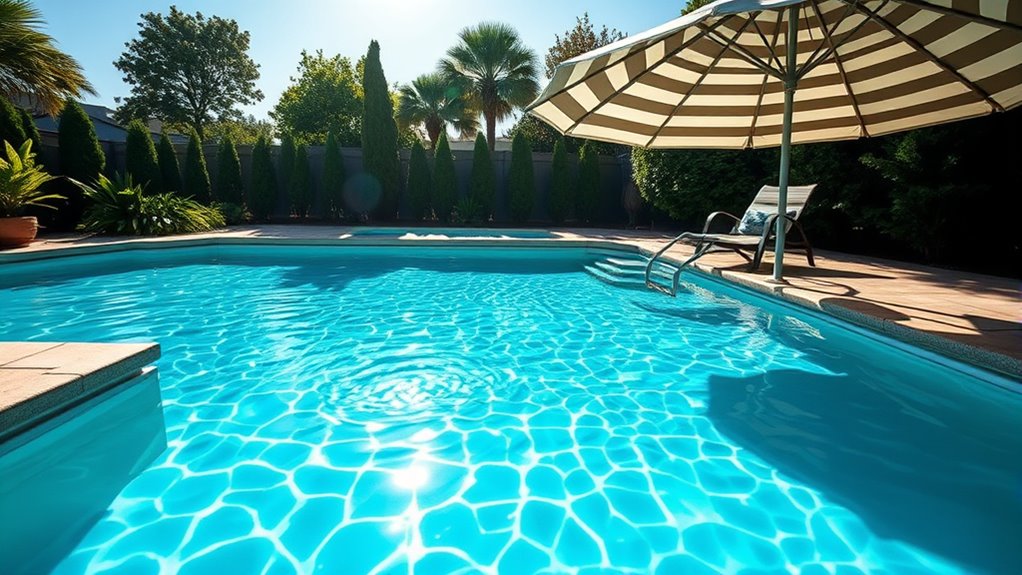
One common mistake that leads to chlorine loss is adding chlorine directly to water that hasn’t been properly balanced or adjusted. When you do this, UV rays and sunlight quickly break down the chlorine before it can do its job. To visualize, consider this table:
| Step | Mistake | Result |
|---|---|---|
| Adding chlorine | Without testing or balancing | Rapid chlorine dissipation |
| Not adjusting pH | Too high or low pH | Reduced chlorine effectiveness |
| Ignoring stabilizer levels | Insufficient stabilizer | Faster chlorine loss |
| Overdosing chlorine | Excessive amounts | Increased chemical waste |
| Poor circulation | Stagnant water | Uneven chlorine distribution |
Avoid these mistakes to keep your pool properly sanitized and minimize unnecessary chlorine loss.
Frequently Asked Questions
How Does Weather Affect Chlorine Stability and Effectiveness?
Weather substantially impacts your chlorine’s stability and effectiveness. Hot, sunny days cause chlorine to dissipate faster due to increased UV exposure and higher temperatures, so you need to check and maintain proper chlorine levels more frequently. Conversely, cooler or cloudy weather slows chlorine loss, making it last longer. Rain can dilute chlorine, reducing its effectiveness, so you should test your water regularly and adjust your chlorination schedule accordingly to keep your pool safe and clean.
Can Pool Covers Completely Prevent Chlorine Degradation?
Like a fortress protecting a treasure, a pool cover can considerably reduce chlorine degradation, but it can’t completely prevent it. UV rays and environmental factors still seep through tiny gaps, slowly breaking down chlorine molecules. You need to maintain proper chemical levels and regularly test your water, even with a cover. Think of it as shielding your pool—effective but not infallible—so consistent maintenance remains essential for clear, clean water.
What Is the Ideal Cyanuric Acid Level for Varying Climates?
You should keep your cyanuric acid (CYA) level between 30 and 50 ppm for most climates. In warmer, sunnier areas, aim for around 50 ppm to protect chlorine from UV degradation. In cooler or shaded regions, 30 ppm suffices. Regularly test your CYA levels and adjust accordingly to maintain effective chlorine protection, ensuring your pool stays sanitized without overspending on chemicals.
How Often Should Chlorine Levels Be Tested in Different Sunlight Conditions?
You should test your chlorine levels at least two to three times a week in direct sunlight to guarantee proper sanitation, as UV rays break down chlorine faster. In shaded areas, testing once a week is usually sufficient. Always monitor your levels regularly, especially during hot, sunny days, to maintain a safe, effective chlorine balance. Consistent testing helps prevent algae growth and keeps your pool clean and safe for swimmers.
Are There Eco-Friendly Alternatives to Cyanuric Acid?
Yes, eco-friendly alternatives to cyanuric acid exist. You can use natural stabilizers like vitamin C (ascorbic acid), which quickly neutralizes chlorine without harming the environment. Additionally, maintaining proper pool chemistry, reducing chemical use, and incorporating saltwater systems help lower the need for stabilizers altogether. These options minimize environmental impact, keep your pool safe, and reduce chemical runoff, making them better choices for eco-conscious pool owners.
Conclusion
So, next time you think sunlight’s your friend, remember it’s also your pool’s worst enemy. Shade and CYA might seem like tricks to save chlorine, but they’re really just your pool’s way of fighting back. Ironically, the brighter the sun, the more you need to tweak your routine. Keep an eye on those levels, or you’ll find yourself chasing chlorine instead of enjoying your swim. Who knew the sun had such a mischievous side?
